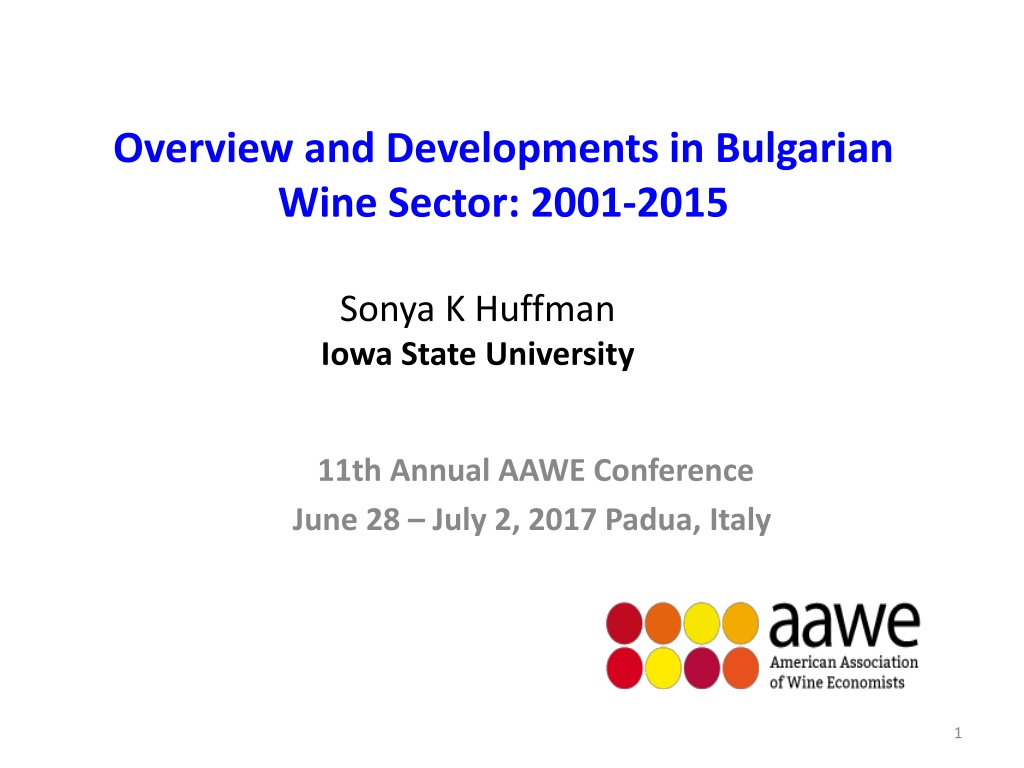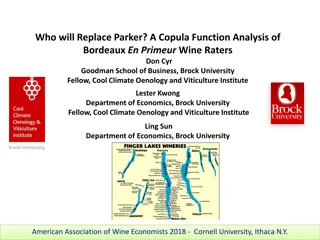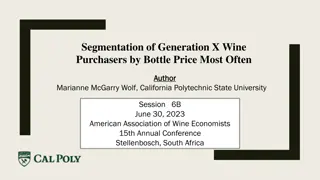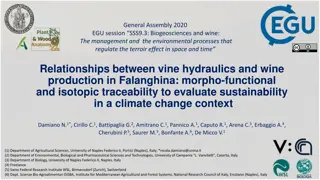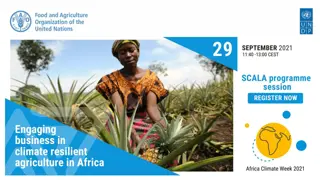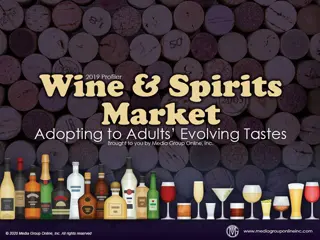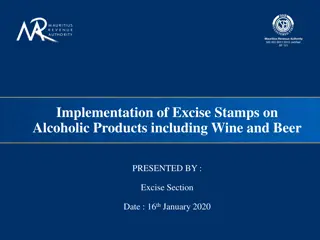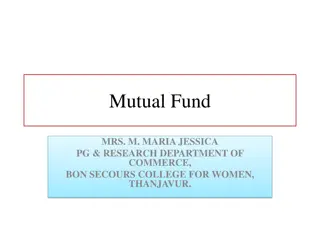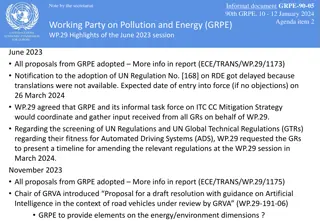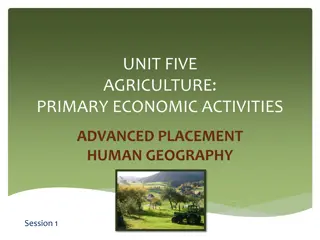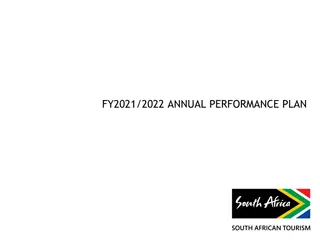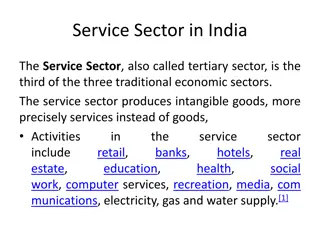Developments in Bulgarian Wine Sector: 2001-2015
Bulgaria, with a rich history of wine production dating back thousands of years, has seen significant changes in its wine industry since the early 1990s. The country's climate and soils provide ideal conditions for grape cultivation across diverse regions. Different wine regions in Bulgaria specialize in various grape varieties, with red wine grapes dominating the cultivation. The study aims to analyze the trends in wine production and consumption in Bulgaria from 2001 to 2015.
Download Presentation

Please find below an Image/Link to download the presentation.
The content on the website is provided AS IS for your information and personal use only. It may not be sold, licensed, or shared on other websites without obtaining consent from the author. Download presentation by click this link. If you encounter any issues during the download, it is possible that the publisher has removed the file from their server.
E N D
Presentation Transcript
Overview and Developments in Bulgarian Wine Sector: 2001-2015 Sonya K Huffman Iowa State University 11th Annual AAWE Conference June 28 July 2, 2017 Padua, Italy 1
Introduction Bulgaria is an upper middle-income economy of 7.2 million people with a per capita income of $6,839. (GDP per capita, 2015.) Bulgaria has a long history of wine production: Began at least 3000 years ago with the ancient Thracians Under the previous socialist economic system, the state nationalized all vineyards and wineries, creating a single state monopoly Vinprom. Since the early 1990s, the wine industry has undergone liberalization as state owned enterprises were sold to private investors. 2
The goal of the study To analyze the developments in the production and consumption of wine in Bulgaria for the 2001-2015 3
Climate and Soils in Bulgaria Bulgaria s climate and soils create excellent conditions for growing superior grapes and wine production. In Bulgaria, there are all four seasons The climate in South of Bulgaria is intermediate continental, tending to Mediterranean Northern Bulgaria is distinguished by its temperate continental climate. The soils are diverse between the various regions of the country. there are cinnamon and grey forest soils, humic-carbonic soils, acidic soils, fertile black earth (chernozems), mountain soils, alluvial-meadow, including both deep and shallow sandy soils, and others. 4
Wine Regions in Bulgaria Danube Plain (northern) region--The fertile plains are home to 35% of Bulgaria vineyards Wines produced are red and whites Black Sea Coast (eastern) region--about 30% of Bulgaria s vineyards; white wines The Valley of Roses (sub-Balkan) region--dry whites: famous for Misket Thracian Lowland (southern) region most famous wine grape: the red, spicy Mavrud Struma River Valley (western) region red wines, Cabernet Sauvignon & Merlot 5
Grape Varieties in Bulgaria There are around 200 different grape varieties (Pleven Institute) The red wine grape varieties dominate and represent about 63% of the cultivated vines, while white wine grape varieties represent about 31%, and dessert grape varieties 6%. The largest share of the red grape varieties is: Pamid; Merlot and Cabernet Sauvignon; Gamza; Melnik The largest share of white grape varieties is represented by: Rkatsiteli; Dimyat; Red Misket; Muscat Ottonel; Chardonnay The traditional Bulgarian grape varieties that are most popular and considered to be of greatest significance are Mavrud, Gamza, Melnik, Ruen, Rubin, Pamid, Dimyat and Red Misket. 6
Total Vineyard Area, Bulgaria, HA, 2001-2015 140000 120000 100000 80000 Total vineyard area HA harvested 60000 40000 20000 0 2001 2002 2003 2004 2005 2006 2007 2008 2009 2010 2011 2012 2013 2014 2015 7
Production Bulgaria is specializing in production of wine grapes. Red varieties (mainly Merlot, Cabernet and Pamid) dominate with 63% of total area 31% planted to white varieties (mainly Red Misket, Muscat Ottonel, and Rkatsiteli) Grape production and utilization: grapes for wine manufacturing 93% wine making commercial wine and home made wine Wine Production in Bulgaria, 1 000 hl, 2001-2014 2500 2000 1500 1000 500 0 2001 2002 2003 2004 2005 2006 2007 2008 2009 2010 2011 2012 2013 2014 2015 8
Problemsand Challenges Poor quality grapes; grape harvesting; wine-making technology, such as lack of modern filtration and bottling lines or refrigeration; improper management of inputs. Total Bulgarian vineyard area has been decreasing since 2000 (declined by 51%). The fragmentation in production and the high number of small vineyards and farms led to substantial problems with investment and marketing. 9
Wine consumption 25.00 Wine Consumption per capita in Bulgaria, in liters 2000-2015 20.00 15.00 10.00 5.00 0.00 2000 2001 2002 2003 2004 2005 2006 2007 2008 2009 2010 2011 2012 2013 2014 2015 It dropped from 6.7 l in 2009 to 4.4 l in 2012, and 2015-5.7 l. The decline in wine consumption over the years is due to change in the composition in alcohol consumption, or an increased consumption of beer and stronger spirits. But over the years there has been increased demand for a higher/better quality wine. 10
Wine consumption per capita is the lowest among the European Union countries Wine consumption estimates vary widely due to the inaccurate data on home- made wine and grey sector shares. 11
Bulgaria Wine's share of total alcohol (liters of alcohol) consumption, %, 2000-2009 25.0 20.0 15.0 10.0 5.0 0.0 2000 2001 2002 2003 2004 2005 2006 2007 2008 2009 12
Summary Bulgaria has a long history of vineyards cultivation and wine production. Bulgaria s climate, soils and temperature create excellent weather conditions for growing superior grapes and wine production. After years of decline, Bulgaria s wine sector started to grow in 2013 and 2014, thanks to increased investments in wineries and vineyards. The decline in wine consumption over the years is due to change in the composition in alcohol consumption But over the years there has been increased demand for a higher/better quality wine. 13
